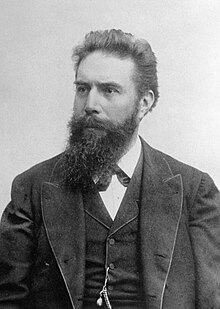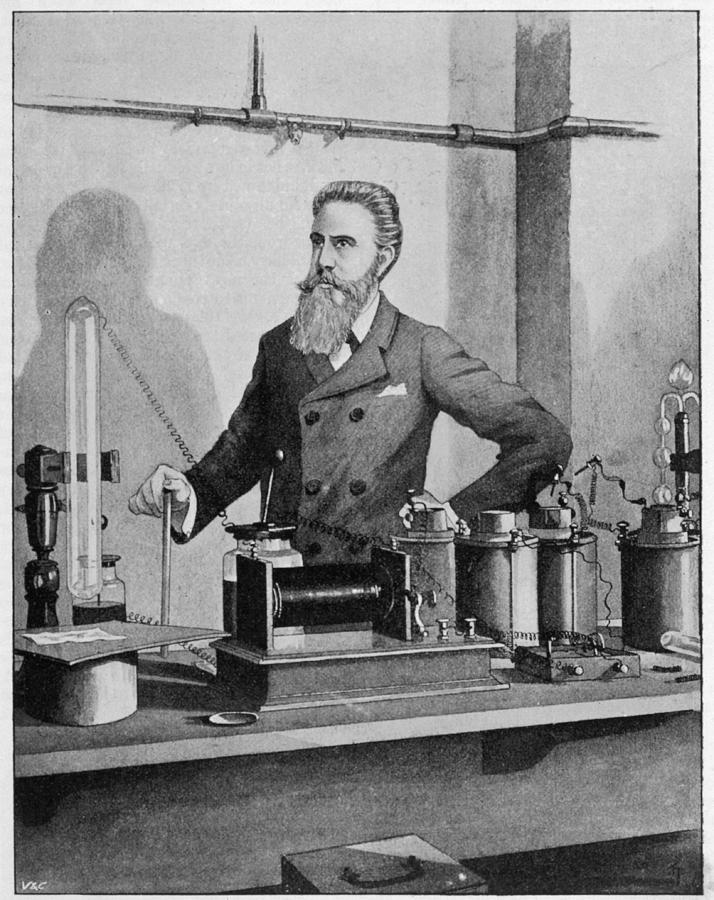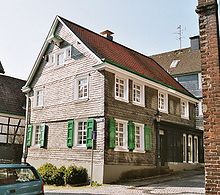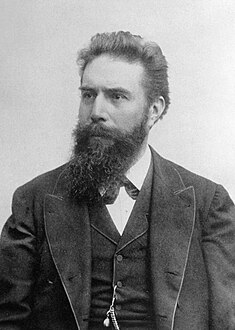
فيلهلم كونراد رونتغن
Wilhelm Röntgen

Jump to navigationJump to search
|
Wilhelm Röntgen
|
|
|---|---|
 |
|
| Born |
Wilhelm Conrad Röntgen
27 March 1845 |
| Died | 10 February 1923 (aged 77) |
| Nationality | German[1] |
| Alma mater | |
| Known for | Discovery of X-rays |
| Awards | Matteucci Medal (1896) Rumford Medal (1896) Elliott Cresson Medal (1897) Barnard Medal (1900) Nobel Prize in Physics (1901) |
| Scientific career | |
| Fields | Physics X-ray astronomy |
| Institutions | |
| Doctoral advisor | August Kundt |
| Doctoral students | |
| Other notable students | Franz S. Exner |
| Signature | |
Wilhelm Conrad Röntgen (/ˈrɛntɡən, –dʒən, ˈrʌnt-/;[2] German: [ˈvɪlhɛlm ˈʁœntɡən]; 27 March 1845 – 10 February 1923) was a German[1] mechanical engineer and physicist, who, on 8 November 1895, produced and detected electromagnetic radiation in a wavelength range known as X-rays or Röntgen rays, an achievement that earned him the first Nobel Prize in Physics in 1901.[3] In honour of his accomplishments, in 2004 the International Union of Pure and Applied Chemistry (IUPAC) named element 111, roentgenium, a radioactive element with multiple unstable isotopes, after him.
Education
He was born to Friedrich Conrad Röntgen, a German merchant and cloth manufacturer, and Charlotte Constanze Frowein.[4] His mother was Dutch and at age three his family moved to Holland where her family lived.[4] Röntgen attended high school in Utrecht, Netherlands; Utrecht Technical School.[4] He followed courses at the Technical School for almost two years.[5] In 1865, he was unfairly expelled from high school when one of his teachers intercepted a caricature of one of the teachers, which was drawn by someone else.
Without a high school diploma, Röntgen could only attend university in the Netherlands as a visitor. In 1865, he tried to attend Utrecht University without having the necessary credentials required for a regular student. Upon hearing that he could enter the Federal Polytechnic Institute in Zurich (today known as the ETH Zurich), he passed the entrance examination and began studies there as a student of mechanical engineering.[4] In 1869, he graduated with a PhD from the University of Zurich; once there, he became a favorite student of Professor August Kundt, whom he followed to the University of Strasbourg.[6]
Career
|
This section needs additional citations for verification. (November 2010) (Learn how and when to remove this template message)
|
In 1874, Röntgen became a lecturer at the University of Strasbourg. In 1875, he became a professor at the Academy of Agriculture at Hohenheim, Württemberg. He returned to Strasbourg as a professor of physics in 1876, and in 1879, he was appointed to the chair of physics at the University of Giessen. In 1888, he obtained the physics chair at the University of Würzburg, and in 1900 at the University of Munich, by special request of the Bavarian government.
Röntgen had family in Iowa in the United States and planned to emigrate. He accepted an appointment at Columbia University in New York City and bought transatlantic tickets, before the outbreak of World War I changed his plans. He remained in Munich for the rest of his career.
During 1895, at his laboratory in the Würzburg Physical Institute of the University of Würzburg, Röntgen was investigating the external effects from the various types of vacuum tube equipment – apparatuses from Heinrich Hertz, Johann Hittorf, William Crookes, Nikola Tesla and Philipp von Lenard — when an electrical discharge is passed through them.[7][8] In early November, he was repeating an experiment with one of Lenard’s tubes in which a thin aluminium window had been added to permit the cathode rays to exit the tube but a cardboard covering was added to protect the aluminium from damage by the strong electrostatic field that produces the cathode rays. He knew the cardboard covering prevented light from escaping, yet Röntgen observed that the invisible cathode rays caused a fluorescent effect on a small cardboard screen painted with barium platinocyanide when it was placed close to the aluminium window. It occurred to Röntgen that the Crookes–Hittorf tube, which had a much thicker glass wall than the Lenard tube, might also cause this fluorescent effect.
In the late afternoon of 8 November 1895, Röntgen was determined to test his idea. He carefully constructed a black cardboard covering similar to the one he had used on the Lenard tube. He covered the Crookes–Hittorf tube with the cardboard and attached electrodes to a Ruhmkorff coil to generate an electrostatic charge. Before setting up the barium platinocyanide screen to test his idea, Röntgen darkened the room to test the opacity of his cardboard cover. As he passed the Ruhmkorff coil charge through the tube, he determined that the cover was light-tight and turned to prepare the next step of the experiment. It was at this point that Röntgen noticed a faint shimmering from a bench a few feet away from the tube. To be sure, he tried several more discharges and saw the same shimmering each time. Striking a match, he discovered the shimmering had come from the location of the barium platinocyanide screen he had been intending to use next.
Röntgen speculated that a new kind of ray might be responsible. 8 November was a Friday, so he took advantage of the weekend to repeat his experiments and made his first notes. In the following weeks, he ate and slept in his laboratory as he investigated many properties of the new rays he temporarily termed “X-rays”, using the mathematical designation (“X”) for something unknown. The new rays came to bear his name in many languages as “Röntgen rays” (and the associated X-ray radiograms as “Röntgenograms”).
At one point while he was investigating the ability of various materials to stop the rays, Röntgen brought a small piece of lead into position while a discharge was occurring. Röntgen thus saw the first radiographic image, his own flickering ghostly skeleton on the barium platinocyanide screen. He later reported that it was at this point that he determined to continue his experiments in secrecy, because he feared for his professional reputation if his observations were in error.
About six weeks after his discovery, he took a picture – a ((radiograph)) – using X-rays of his wife Anna Bertha’s hand. When she saw her skeleton she exclaimed “I have seen my death!”[9] He later made a better picture of his friend Albert von Kölliker‘s hand at a public lecture.
Röntgen’s original paper, “On A New Kind of Rays” (Ueber eine neue Art von Strahlen), was published on 28 December 1895. On 5 January 1896, an Austrian newspaper reported Röntgen’s discovery of a new type of radiation. Röntgen was awarded an honorary Doctor of Medicine degree from the University of Würzburg after his discovery. He published a total of three papers on X-rays between 1895 and 1897.[10] Today, Röntgen is considered the father of diagnostic radiology, the medical speciality which uses imaging to diagnose disease.
A collection of his papers is held at the National Library of Medicine in Bethesda, Maryland.[11]
Personal life

Grave of Wilhelm Röntgen at Alter Friedhof (old cemetery) in Gießen
Röntgen was married to Anna Bertha Ludwig for 47 years until her death in 1919 at age 80. In 1866 they met in Zürich at Anna’s father’s café, Zum Grünen Glas. They got engaged in 1869 and wed in Apeldoorn, The Netherlands on 7 July 1872. It was delayed due to Anna being six years Wilhelm’s senior and his father not approving of her age or humble background. Their marriage began with financial difficulties as family support from Röntgen had ceased. They raised one child, Josephine Bertha Ludwig, whom they adopted at age 6 after her father, Anna’s only brother, died in 1887.[12]

First medical X-ray by Wilhelm Röntgen of his wife Anna Bertha Ludwig’s hand

X-ray of Albert von Kölliker‘s hand
He inherited two million Reichsmarks after his father’s death.[13] For ethical reasons, Röntgen did not seek patents for his discoveries, holding the view that it should be publicly available without charge. After receiving his Nobel prize money, Röntgen donated the 50k Swedish crown to research at the University of Würzburg. Although he accepted the honorary degree of Doctor of Medicine, he rejected an offer of lower nobility, or Niederer Adeltitel, by denying the preposition von (meaning “of”) as a nobiliary particle (i.e., von Röntgen).[14] With the inflation following World War I, Röntgen fell into bankruptcy later in life, spending his final years at his country home at Weilheim, near Munich.[7] Röntgen died on 10 February 1923 from carcinoma of the intestine, also known as colorectal cancer.[15] In keeping with his will, all his personal and scientific correspondence was destroyed upon his death.[citation needed][dubious ][16]
Honours and awards
|
This section needs additional citations for verification. (November 2016) (Learn how and when to remove this template message)
|
In 1901, Röntgen was awarded the first Nobel Prize in Physics. The award was officially “in recognition of the extraordinary services he has rendered by the discovery of the remarkable rays subsequently named after him”. Röntgen donated the monetary reward from his Nobel Prize to his university.[clarification needed] Like Pierre Curie, Röntgen refused to take out patents related to his discovery of X-rays, as he wanted society as a whole to benefit from practical applications of the phenomenon. Röntgen was also awarded Barnard Medal for Meritorious Service to Science in 1900.[17]
His honors include:
- Rumford Medal (1896)
- Matteucci Medal (1896)
- Elliott Cresson Medal (1897)
- Nobel Prize for Physics (1901)
- In November 2004 IUPAC named element number 111 roentgenium (Rg) in his honour. IUPAP adopted the name in November 2011.
In 1907 he became a foreign member of the Royal Netherlands Academy of Arts and Sciences.[18]
Legacy
Today, in Remscheid-Lennep, 40 kilometres east of Düsseldorf, the town in which Röntgen was born in 1845 is the Deutsches Röntgen-Museum.[19]
In Würzburg, where he discovered the X-rays, a non-profit organization maintains his laboratory and provides guided tours to the Röntgen Memorial Site.[20]
World Radiology Day: The International Day of Radiology is an annual event promoting the role of medical imaging in modern healthcare. It is celebrated on 8 November each year, coincides with the anniversary of the discovery of X-rays by Wilhelm Roentgen in 1895. It was first introduced in 2012, as a joint initiative, by the European Society of Radiology (ESR), the Radiological Society of North America (RSNA), and the American College of Radiology (ACR).
Röntgen Peak in Antarctica is named after Wilhelm Röntgen
فيلهلم كونراد رونتغن (1845-1923) عالم فيزيائي ألماني الجنسية.[17][18][19] مُكتشف الأشعة السينية التي تعرف بأشعة إكس أو أشعة رونتغن عام 1895. ودرس كثيراً من خصائصها وقد فتح اكتشافه هذا آفاقاً في مجالي الطب والفيزياء. حصل على جائزة نوبل في الفيزياء عام 1901.
النشأة
ولد روتنغن في مدينة لينب ((التي تعرف حالياً بـ رمشايد)) في رهينش بروسيا وكان الطفل الوحيد لتاجر وصانع ملابس. تدعى امه تشارلوت فراوين كونستانز أمستردام. في مارس 1848 انتقل مع عائلته إلى مدينة أبلدورن وتربى فيلهلم في هولندا. تلقى بداية تعليمه في مدرسة داخلية تسمى (معهد فان دورن مارتينوس هيرمان) في أبلدورن من 1861 حتي 1863. ألتحق بمدرسة امبخت في اترخت وقال انه طرد لرفضه الكشف عن هوية زميل كان متهماً لرسم صورة سيئة لأحد المعلمين في المدرسة. ليس فقط كان طرد وقال انه تبين لاحقا انه لا يستطيع الألتحاق بأي صالة للألعاب الرياضية الأخرى الهولندية أو الألمانية. في عام 1865 حاول أن يلتحق بجامعة اوترخت بدون أن يحصل على شهادة كالطلاب الأخرىن. سُمع انه التحق بـالمعهد الفدرالي السويسري في معهد زيوريخ(الذي يعرف الآن باسم تي إتش زيوريخ) اجتاز الأمتحانات هناك وبدأ الدراسة هناك كطالب في الهندسة الميكانيكية. في عام 1869 تخرج وحصل على شهادة الدكتوراه من جامعة زيوريخ ،ومرة واحدة أصبح الطالب المفضل للأستاذ أغسطس آونت الذي كان يتبع لجامعة ستراسبورغ في 1873.
الحياة الوظيفية
في عام 1874 أصبح روتنغن مُحاضر في جامعة ستراسبورغ ،وفى عام 1875 أصبح استاذاً في أكاديمية الزراعة في هوهنهايم ،فورتمبرغ. عاد مرة أخرى لجامعة ستراسبورغ أستاذاَ للفيزياء في عام 1876. وفي عام 1879 تم تعيينه لرئاسة قسم الفيزياء في جامعة غيسن. وفي عام 1888 تم تعيينه لرئاسة جامعة فورتسبورغ وفي عام 1900 تم تعيينه لرئاسة جامعة ميونيخ نتيجة طلب خاص من حكومة ولاية بافاريا. وكان لرونتغن عائلة في ولاية ايوا في الولايات المتحدة وقد قرر المهاجرة. وعلى الرغم من انه قَبل موعد في جامعة كولومبيا في مدينة نيويورك وكان قد اشترى بالفعل تذاكر عبر المحيط الأطلسي ،ولكن اندلاع الحرب العالمية غيرت خططه وبقي في ميونيخ لبقية حياته.
اكتشاف الأشعة السينية
في خلال عام 1895 كان روتنغن يتحقق من التأثير الخارجي لأنواع عديدة من أجهزة الأنابيب المفرغة من خلال هندش هرتز ويوهان فيلهلم هتورف وويليام كروكس ونيكولا تيسلا وفيليب فان لينرد. عندما مرت شحنة كهربائية خلالهم في بداية نوفمبر ،كان يعيد تجربه مع واحدة من أنابيب لينارد التي تم إضافه صمام ألومنيوم رفيع لها لكي يسمح لأشعة الكاثود أن تخرج من الانبوبة ولكن غطاء كرتوني تمت إضافته لكي يحمي الالومنيوم من الدمار من الأشعة الإلكتروستاتيكية القوية اللازمة لإنتاج اشعة الكاثود. هو علم أن الغطاء الكرتوني يمنع الضوء من الهروب ومع ذلك لاحظ رونتغن أن أشعة الكاثود الغير مرئية سببت تأثير مشع على شاشة كرتون صغيرة مطلاه بباريوم بلاتينوسيانيد عندما وضعت بجانب صمام زجاجي ،وهيئ لرونتغن أن هيتولف كروكس التي لها جدار زجاجى أسمك من أنبوبة لينارد من الممكن أيضا أن تسبب نفس التأثير المشع. في وقت متأخر بعد الظهر من 8 نوفمبر عام 1895 ،[بحاجة لمصدر] قرر روتنغن أن يختبر فكرتة فقام بعناية بتصميم غطاء كرتوني أسود متشابه للذي استخدمه في أسطوانة لينارد فقام بتغطية أنبوبه هيتولف كروكس بكرتون وملصق بها الكترود لملف رمكورف لتولد شحنة كهروستاتيكية. قبل إنشاء شاشة الباريوم بلاتينوسيانيد ليجرب فكرتة قام روتنغن بتظليم الغرفة ليختبر عدم نفاذ الغطاء الكرتوى. عندما مرر ملف رمكورف خلال الأنبوبة قام بتحديد لإن الغطاء كان ضوءه محكم و اتجه لتحضير الخطوة التالية من التجربة في هذه اللحظة لاحظ روتنغن وميض خافت من مقعد يبعد مترا عن الانبوب ولكي يتأكد قام باختبار العديد من الشحنات ورأى نفس الوميض في كل محاولة واكتشف ان الوميض كان يخرج من مكان شاشة الباريوم بلاتينوسيانيد التي كان ينوي اختيارها بعد ذلك. وتكهن روتنغن أن نوع جديداً من الأشعة قد يكون مسؤلاً. يوم الجمعة 8 نوفمبر استغل هذه العطلة لإعادة تجربته ويبدأ في تدوين ملاحظاته. في الأسابيع التالية لهذا اليوم كان يأكل وينام في معمله حتى تحقق من الكثير من خصائص الأشعة الجديدة التي سمها مؤقتاً أشعة إكس ،باستخدام التسمية الرياضي لشيئ مجهول. على الرغم من أن الأشعة الجديدة عرفت بأسماء كثيرة في لغات عديدة حتى أصبحت تعرف باسم أشعة روتنغن ،كان روتنغن يفضل اسم أشعة اكس. بعد أسبوعين تقريباً من اكتشافه ،أخذ أول صورة له باستخدام أشعة اكس على يد زوجتة آنا بيرثا. عندما رأت عظمها قالت: “لقد رأيت موتي”. الفكرة التي لاحظها روتنغن وميض خفيف من شاشة الباريوم بلاتينوسيانيد من خلال حسن الحظ تشوه صلاحيات التحقيق ،خططت ان يستخدم الشاشة في الخطوة التالية في تجربته ولذلك سيحصل على الإكتشاف بصرف النظر عن اللحظات القليلة الماضية في نقطة واحدة عندما كان يتحقق من قدرة المواد المختلفة لوقف الأشعة ،روتنغن أحضر قطعة صغيرة من الرصاص في الموقع بينما كلن يحدث التفريغ ،شهد روتنغن بذلك أول صورة اشعاعية لهيكلة العظمى على شاشة الباريوم بلاتينوسيانيد. وكتب في وقت لاحق انه كان يريد مواصلة تجاربة في سرية ،خوفاً على سمعته المهنية إذا كانت ملاحظاته خطأ. وقد نشرت ورقة روتنغن الأصلية بعد 50 عاماً 28 ديسمبر 1895. في 5 يناير 1896 جريدةنمساوية كتبت عن إكتشاف روتنغن لنوع جديد من الأشعة. حصل روتنغن على درجة دكتوراة شرفية في الطب من جامعة فورتسبورغ بعد اكتشافه. نشر ثلاثة أوراق عن أشعة إكس 1895–1897. اليوم ،يعتبر رونتغن والد الأشعة التشخيصية ،والتخصص الطبي الذي يستخدم التصوير لتشخيص المرض.
الحياة الشخصية
كان روتنغن متزوج من آنا بيرثا لودفيغ (1872-1919) ,كان لديه طفل واحد جوزفين بيرثا لودفيغ أعُتمدت في سن السادسة عام 1887 ,كانت ابنه آخ آنا. مات روتنغن في العاشر من فبراير عام 1923 من سرطان الامعاء. لا يُعتقد ان مرضة كان بسبب عمله في الاشعاعات المؤينة لأنه قضى وقت قصير في الأكتشاف وانه كان واحد من الرواد القلائل في هذا المجال الذين استخدموا دروع واقية الرصاص بشكل روتيني. ووفقاً لأرادتة كل مرسلاته الشخصية والعلمية دُمرت بعد موته.
الأوسمة والجوائز
في عام 1901 مُنح روتنغن أول جائزة نوبل في الفيزياء وكانت الجائزة رسميا “تقديرا للخدمات استثنائية التي قدمها لأكتشاف أشعة رائعة سُمت من بعده”. تبرع روتنغن بالمكافأة النقدية من جائزة نوبل لجامعته. مثل بيار كوري رفض روتنغن إخراج براءة اختراع لأكتشافه كما انه يريد البشرية جمعاء من الاستفادة من التطبيقات العملية ل(بيان شخصي) نفسه. حتى انه لم يريد تسمية الأشعة من بعدة.
- وسام رمفورد (1896).
- وسام ماتيوسى (1896).
- وسام إليوت كريسون (1897).
- جائزة نوبل في الفيزياء (1901).
- في نوفمبر 2004 قام الاتحاد الدولي للكيمياء البحتة والتطبيقية تسمية العنصر الـ111 باسم رونتجينيوم
تكريماً له.
الإرث
- اليوم ،في رمشايد-لينيب 40 كيلومتر شرق مدينة دوسلدورف يوجد المنزل الذي ولد فيه روتنغن عام 1845 الذي أصبح الآن متحف باسم (متحف روتنغن الألماني).
- في العديد من اللغات يستخدم اسم روتنغن للإشارة إلى الأشعة ومنتجاتها بدلا من مصطلح “أشعة سينية” مثل في اليابانية “rentogen” والليتوانية “rentgeno” والعبرية “rentgen” والكرواتية “rentgen”ولغات أخرى
.
شاهد بالفيديو.. هكذا اكتشف “كونراد رونتجن”.. الأشعة السينية بمحض الصدفة!
قبل 120 عاماً اكتشف الفيزيائي كونراد رونتجن أشعة كهرومغناطيسية بالصدفة لم تكن معروفة له. لم يكن رونتجن يعلم أنه قد اكتشف الأشعة السينية التي ستلعب دورا كبيراً في مجالات الطب والصناعة والأمن حتى يومنا هذا.
لم يخطر على بال أستاذ الفيزياء بجامعة فورتسبورج كونراد رونتجن في نوفمبر 1895 أنه سيكتشف الأشعة السينية.
كان رونتجن يعمل في مختبره بمعهد الفيزياء بجامعة يوليوس – ماكسيميليانس على أنابيب الكاثود، يحاول مراقبة الأضواء الصادرة من تجربته على هذه الأنابيب. رونتجن لاحظ أن زجاجا على مسافة بعيدة، كان لا يجب أن يصلها الضوء، بدأت تشع، رغم أن هناك لوحا خشبيا وورقة من الكربون بين مصدر الإشعاع والزجاج.
أصابت رونتجن الدهشة، ولم يخرج لمدة أسابيع من مختبره الذي يقع فوق غرفة نومه، وبقي يبحث في سبب هذه الظاهرة.
كتشف أشعة كهرومغناطيسية غير معروفة، أُطلق عليها بالانجليزية بعد ذلك أشعة X، فيما أُطلق عليها في ألمانيا تيمنا بمكتشفها أشعة رونتجن.
رونتجن أخذ أول صورة لجسد إنسان يوم 22 من كانون الأول/ ديسمبر 1895 ليد زوجته. وبعد ستة أيام كشف رونتجن عن اكتشافه لأشعة غير معروفة. وفي عام 1901 حصل رونتجن على جائزة نوبل في الفيزياء.
في الحرب العالمية الأولى بدأ الأطباء باستخدام الأشعة على نطاق واسع، ليس فقط لاكتشاف الكسور، بل حتى لفحص الالتهابات البكتيرية.
وفى زمننا هذا تستعمل الأشعة أيضا خلال العمليات. وحتى في مجالات الفحص الأمني تستعمل رونتجن لفحص الحقائب، وفي المجال الصناعي تستعمل الأشعة لفحص المواد كذلك.
حتى منتصف خمسينات القرن الماضي كان الأطباء يستعملون الأشعة من دون تحفظ على آثارها الجانبية. إذ اكتشف الأطباء والفيزيائيين أن كثرة التعرض للأشعة يمكن أن تسبب الإصابة بالسرطان.
رونتجن توفي عام 1923 بعمر 77 بعد إصابته بسرطان القولون. لكن إصابته بالمرض لم تكن نتيجة تعرضه لأشعته، لأنه تعرض لجرعات قليلة نسبيا.
حول رونتجن
ولد روتنجن في مدينة لينب (التي تعرف حالياً بـ رمشايد) في رهينش بروسيا وكان الطفل الوحيد لتاجر وصانع ملابس. تدعى امه تشارلوت فراوين كونستانز أمستردام. في مارس 1848 انتقل مع عائلته إلى مدينة أبلدورن وتربى فيلهلم في هولندا. تلقى بداية تعليمه في مدرسة داخلية تسمى (معهد فان دورن مارتينوس هيرمان) في أبلدورن من 1861 حتي 1863.
إلتحق بمدرسة امبخت في اترخت وقال انه طرد لرفضه الكشف عن هوية زميل كان متهماً لرسم صورة سيئة لأحد المعلمين في المدرسة. ليس فقط كان طرد وقال انه تبين لاحقا انه لا يستطيع الألتحاق بأي صالة للألعاب الرياضية الأخرى الهولندية أو الألمانية.
في عام 1865 حاول أن يلتحق بجامعة اوترخت بدون أن يحصل على شهادة كالطلاب الأخرىن. سُمع انه التحق بـالمعهد الفدرالي السويسري في معهد زيوريخ (الذي يعرف الآن باسم تي إتش زيوريخ) اجتاز الأمتحانات هناك وبدأ الدراسة هناك كطالب في الهندسة الميكانيكية. في عام 1869 تخرج وحصل على شهادة الدكتوراه من جامعة زيوريخ، ومرة واحدة أصبح الطالب المفضل للأستاذ أغسطس آونت الذي كان يتبع لجامعة ستراسبورغ في 1873.
الحياة الوظيفية
في عام 1874 أصبح روتنجن مُحاضر في جامعة ستراسبورج، وفى عام 1875 أصبح استاذاً في أكاديمية الزراعة في هوهنهايم ،فورتمبرغ. عاد مرة أخرى لجامعة ستراسبورج أستاذاَ للفيزياء في عام 1876.
وفي عام 1879 تم تعيينه لرئاسة قسم الفيزياء في جامعة جيسن. وفي عام 1888 تم تعيينه لرئاسة جامعة فورتسبورج وفي عام 1900 تم تعيينه لرئاسة جامعة ميونيخ نتيجة طلب خاص من حكومة ولاية بافاريا. وكان لرونتجن عائلة في ولاية ايوا في الولايات المتحدة وقد قرر المهاجرة. وعلى الرغم من انه قَبل موعد في جامعة كولومبيا في مدينة نيويورك وكان قد اشترى بالفعل تذاكر عبر المحيط الأطلسي، ولكن اندلاع الحرب العالمية غيرت خططه وبقي في ميونيخ لبقية حياته.








